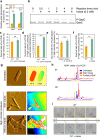Novel indole-mediated potassium ion import system confers a survival advantage to the Xanthomonadaceae family
- PMID: 35319020
- PMCID: PMC9213462
- DOI: 10.1038/s41396-022-01219-6
Novel indole-mediated potassium ion import system confers a survival advantage to the Xanthomonadaceae family
Abstract
Interspecific and intraspecific communication systems of microorganisms are involved in the regulation of various stress responses in microbial communities. Although the significance of signaling molecules in the ubiquitous family Xanthomonadaceae has been reported, the role bacterial communications play and their internal mechanisms are largely unknown. Here, we use Lysobacter enzymogenes, a member of Xanthomonadaceae, to identify a novel potassium ion import system, LeKdpXFABC. This import system participates in the indole-mediated interspecies signaling pathway and matters in environmental adaptation. Compared with the previously reported kdpFABC of Escherichia coli, LekdpXFABC contains a novel indispensable gene LekdpX and is directly regulated by the indole-related two-component system QseC/B. QseC autophosphorylation is involved in this process. The operon LekdpXFABC widely exists in Xanthomonadaceae. Moreover, indole promotes antimicrobial product production at the early exponential phase. Further analyses show that indole enhances potassium ion adsorption on the cell surface by upregulating the production of O-antigenic polysaccharides. Finally, we confirm that LeKdpXFABC mediation by indole is subject to the intraspecific signaling molecules DSFs, of which the biosynthesis genes always exist together with LekdpXFABC. Therefore, as a new idea, the signal collaborative strategy of indole and DSFs might ensure the persistent fitness advantage of Xanthomonadaceae in variable environments.
© 2022. The Author(s), under exclusive licence to International Society for Microbial Ecology.
Conflict of interest statement
The authors declare no competing interests.
Figures







Similar articles
-
Indole-Induced Reversion of Intrinsic Multiantibiotic Resistance in Lysobacter enzymogenes.Appl Environ Microbiol. 2017 Aug 17;83(17):e00995-17. doi: 10.1128/AEM.00995-17. Print 2017 Sep 1. Appl Environ Microbiol. 2017. PMID: 28625984 Free PMC article.
-
Interspecies and Intraspecies Signals Synergistically Regulate Lysobacter enzymogenes Twitching Motility.Appl Environ Microbiol. 2019 Nov 14;85(23):e01742-19. doi: 10.1128/AEM.01742-19. Print 2019 Dec 1. Appl Environ Microbiol. 2019. PMID: 31540995 Free PMC article.
-
A novel regulatory circuit to control indole biosynthesis protects Escherichia coli from nitrosative damages during the anaerobic respiration of nitrate.Environ Microbiol. 2017 Feb;19(2):598-610. doi: 10.1111/1462-2920.13527. Epub 2016 Oct 24. Environ Microbiol. 2017. PMID: 27631134
-
QseB/QseC: a two-component system globally regulating bacterial behaviors.Trends Microbiol. 2023 Jul;31(7):749-762. doi: 10.1016/j.tim.2023.02.001. Epub 2023 Feb 26. Trends Microbiol. 2023. PMID: 36849330 Review.
-
Local and Universal Action: The Paradoxes of Indole Signalling in Bacteria.Trends Microbiol. 2020 Jul;28(7):566-577. doi: 10.1016/j.tim.2020.02.007. Epub 2020 Mar 20. Trends Microbiol. 2020. PMID: 32544443 Review.
Cited by
-
Underexplored bacteria as reservoirs of novel antimicrobial lipopeptides.Front Chem. 2022 Oct 5;10:1025979. doi: 10.3389/fchem.2022.1025979. eCollection 2022. Front Chem. 2022. PMID: 36277345 Free PMC article. Review.
-
4F-Indole Enhances the Susceptibility of Pseudomonas aeruginosa to Aminoglycoside Antibiotics.Microbiol Spectr. 2023 Mar 28;11(2):e0451922. doi: 10.1128/spectrum.04519-22. Online ahead of print. Microbiol Spectr. 2023. PMID: 36975825 Free PMC article.
-
Indole-3-acetic acid (IAA) protects Azospirillum brasilense from indole-induced stress.Appl Environ Microbiol. 2025 Apr 23;91(4):e0238424. doi: 10.1128/aem.02384-24. Epub 2025 Mar 25. Appl Environ Microbiol. 2025. PMID: 40130845 Free PMC article.
-
Engineered bacteria as drug delivery vehicles: Principles and prospects.Eng Microbiol. 2022 Jun 21;2(3):100034. doi: 10.1016/j.engmic.2022.100034. eCollection 2022 Sep. Eng Microbiol. 2022. PMID: 39629029 Free PMC article. Review.
References
-
- Li B, Liu J, Zhou S, Fu L, Yao P, Chen L, et al. Vertical variation in Vibrio community composition in Sansha Yongle Blue Hole and its ability to degrade macromolecules. Mar Life Sci Technol. 2020;2:60–72. doi: 10.1007/s42995-019-00003-4. - DOI

